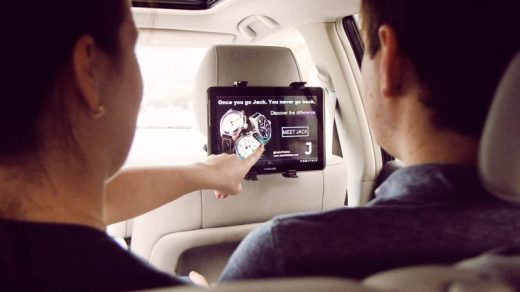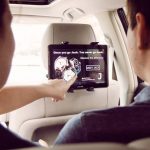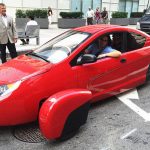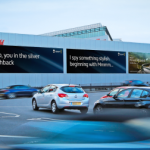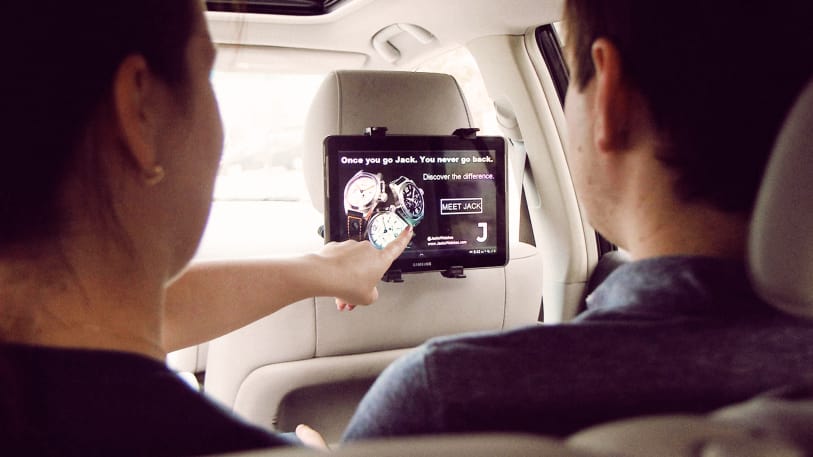Will Ride-Hail Be Free By 2021? The Startup Ad Platform Vugo Says Yes
Earlier this year in Detroit, the North American International Auto Show ended on a different note than in years past. Attendees of the car industry’s annual preening and prognostication session weren’t only predicting what consumers will be most likely to drive; they were forecasting the market for cars that will drive consumers.
This topic was of particular interest to the Minnesota-based ride-hail advertising platform Vugo, whose vision of the future depends on a steady stream of passengers. And that vision is bold: The company’s founders predict that within five years, all U.S. ride-hail vehicles will be not only autonomous, but taking them where you need to go will be free, thanks to ads tailored specifically to those passengers.
Vugo, which was founded in 2015 with a $200,000 pre-seed funding round, currently operates primarily in Uber vehicles, running ads on a tablet that drivers purchase themselves and keep in the back seat to earn extra income on each ride.
The driver takes a 60% cut of Vugo’s advertising revenue, which is built on an ad industry-standard cost-per-impression price structure. The rate shifts with market conditions, but it hovers at about $25 per 1,000 impressions. For a driver, this adds up to approximately $100 to $300 in additional income each month when driving full-time. (It’s separate from the tips customers can add via the Vugo platform, a gratuity Uber drivers are otherwise denied because the customer-facing app does not have a tip function.)
To a passenger, the tablet is free entertainment, with a few ads mixed into the YouTube clips they might skim. Depending on how the driver has set up the tablet’s offerings, a rider could browse Hulu or HBO Go, where they could satisfy a Game of Thrones fix during rush hour. Vugo’s secret sauce is its “TripIntent” technology, an algorithm that derives insights about passengers’ consumer tendencies based on the entertainment they choose, current location, and planned destination in order to deliver more tailored content.
The startup popSLATE used Vugo to advertise its mobile smart case (which creates a screen on the back of your phone) in Ubers ferrying passengers to Los Angeles’s LAX airport. In the coming months, Vugo also plans to build its own cloud-based passenger entertainment network—a Netflix on wheels of sorts that the company’s founder and chief marketing officer James Bellefeuille hopes will become “the world’s largest in-car media platform.” Revenue from ads and content partnerships with networks and studios both serve Bellefeuille’s goal of making fares obsolete. “Our mission is free transportation,” he says.
But that wasn’t always Vugo’s plan. The original idea behind the company was simply to get people to buy something while en route. And it was born from a common millennial experience: the rude shock of post-college budgeting in a big city.
To make ends meet as he started his career, Bellefeuille, now 30, moonlighted as an Uber driver in Chicago on top of his 9-to-5 at an ad firm. When he noticed that his passengers were more likely to patronize his favorite restaurant just because they saw a menu in the backseat of his Prius, it dawned on him that he could try to marry his two gigs. Leveraging his ad-firm knowledge of consumer markets and pricing for ad buys, he saw the potential to quite literally drive consumers to clients.
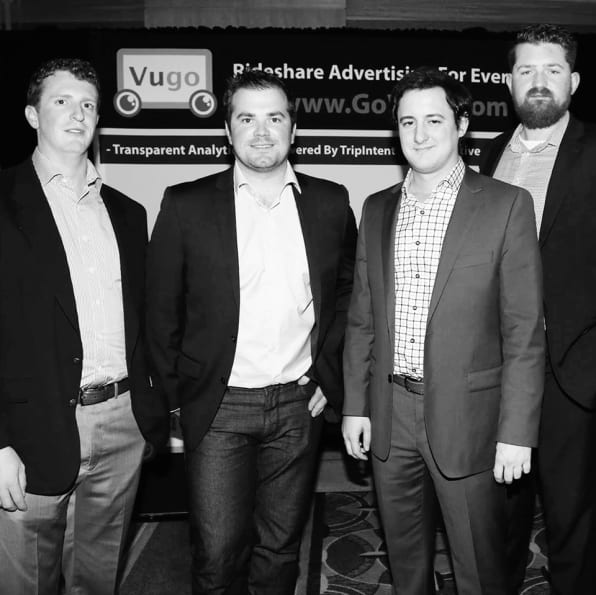
As autonomous vehicles have entered the lexicon in the last year as an inevitable element of future transportation, Bellefeuille and his three cofounders, CEO Rob Flessner, CTO Eugene Kurdzesau, and vice president of sales Michael Dillon, had their free transportation epiphany.
Their thinking goes like this: Ongoing segmentation of the ride-hail market will produce more consumers with a diverse range of preferences—like luxury seekers hiring only BMWs or the eco-conscious swiping up on electric vehicles—which allows smaller, more nimble newcomers to niche-compete with the Ubers and Lyfts. This staves off complete market dominance by major auto manufacturers like GM, Ford, and Toyota. Autonomous vehicles will cut the labor costs of drivers, and eventually, retailers will sponsor transportation to their stores. Those retailers will willingly pay for trips because they can preview products for customers who are heading their way, or they can boost their market research by buying customer insights from Vugo. Once retailers set the bar for free transport, the founders reason, other sectors will follow.
Vugo has been testing its concept with a fleet of tablet-toting Uber drivers in Los Angeles since early 2015. The two companies do not have an official partnership, and Vugo can run on any tablet, in any car. Vugo chose to target Uber because it currently operates in the most cities, and because Uber drivers are more apt to seek an extra earnings opportunity to make up for the lack of tips. Cities targeted for Vugo expansion are Washington, D.C., New York, Chicago, San Francisco, Las Vegas, Austin, Dallas, Houston, Miami, and Boston. (Chicago and New York present hurdles, as both have restrictions on ride-hail advertising. First amendment lawsuits are pending.)
Recently, Vugo has been exploring new avenues of revenue by taking on a new type of client: political interest groups. So far, Vugo’s work in this sector has been limited. Among the few accounts the company took on is the U.S. Chamber of Commerce’s Institute for Legal Reform, which ran a video counting down the most frivolous lawsuits of 2015 in the final quarter of that year in Los Angeles. And the only policy-related messaging currently airing is from the Ad Council, a nonprofit distributor of public service announcements. Through 2017, Vugo will show Ad Council’s messages on welcoming refugees, preventing sexual assault, and embracing diversity and inclusion. (Uber, which in January became a casualty of public uproar over the president’s travel ban, did not respond to emails seeking comment about Vugo running political discourse in its vehicles.)
Bellefeuille says Vugo would happily run more political ads if the company had a greater presence outside of L.A. He says he has had to turn down several requests for this reason, including from political action committees aligned with Hillary Clinton looking to shore up support before the Democratic Convention in Philadelphia last summer, and from the Republican group Delegates Unbound, which hoped to convince delegates at the Republican National Convention in Cleveland that they were not bound by party rules to vote for the presumed nominee.
Because of RNC rules that forbade political messaging inside the arena, targeting delegates in transit was a strategy worth exploring, according to M. Dane Waters, Delegates Unbound cofounder and CEO of the consulting firm Tipping Point Strategies. “The microtargeting was critical because that’s the only way we could reach the delegates,” he says. Though it didn’t work out for Cleveland, Waters is keeping Vugo in mind for future campaigns with his Tipping Point clients. “My sense is it’s a tremendous tool,” Waters says. A longtime professional consultant and personal activist, Waters believes that internet and mobile advertising is the way of the future, calling major television network advertising—in the past a necessary element of major campaigns—“fleeting and expensive.” A 30-second primetime spot on a national network such as CBS can costs tens of thousands of dollars, and it only shows once, with no interaction. “With something like Vugo,” Waters says, “you can show them something with a link to a website or YouTube.” (The ad firm representing the Clinton-aligned PACs declined to comment.)
Bellefeuille is mum on his company’s earnings and five-year-plan specifics, but he projects Vugo will take on more political clients within the year. They’ll pay the same ad rates as consumer product marketers, and he says the company will look to strike a balance between the two sources of revenue. Over the next 18 months, Vugo will expand its driver fleet in major U.S. cities at the same time political movements of every stripe seek creative ways to target specific parts of the electorate in advance of the November 2018 midterm elections.
“You’re going to see a lot of spending from independent expenditures,” says Jordan Lieberman, president of the politics division of Audience Partners, a Washington, D.C.-based ad firm that, like Vugo, uses data to target messaging. Independent expenditures are campaigns that assess candidates on specific issues. Lieberman says he expects big ad buys from his clients on both sides of the political aisle for health care, immigration, parental leave, and tax reform leading up to next year’s midterms.
Already, the fraught post-presidential election climate that has kept much of the electorate engaged presents a unique opportunity for Vugo. According to Eitan Hersh, a Yale political science professor and the author of Hacking the Electorate: How Campaigns Perceive Voters, the company could become a valuable policy tool and maintain ongoing business if it proves effective in energizing Uber riders and inspiring them to call or write to their leaders in Washington between elections. Approaching a vote, the base of each party tends to get vocal, but “those people are hard to mobilize outside an election context,” says Hersh.
While Bellefeuille doesn’t always agree with the messaging that comes across his desk, he maintains that he will take clients from the left or the right, as long as he thinks it’s good business and the ads are factually accurate. “We’re not going to censor anyone,” he says.
As major auto manufacturers increasingly demonstrate a commitment to autonomous vehicles—Ford announced plans last August to release a self-driving car specifically for ride-hail by 2021, and Uber recently partnered with Mercedes-Benz parent company Daimler on an AV plan—Bellefeuille sees a clear path to Vugo’s goal of free rides. In this model, the partnership with ride companies would become more formalized. He imagines a 2021-era weekend errands scenario in which a store like Target (not currently a Vugo partner or client) runs in-car ads for specific products while a shopper is on his or her way there.
Today, Uber takes 25% of the cost of a ride, while the driver pockets the rest. If, as Bellefeuille’s own data shows, the most common ride-hail trip now is two to three miles in distance and between 14 and 21 minutes in length for an average cost of $10, then removing the driver from the equation altogether would reduce the cost to $2.50. And that’s before further scaling and market segmentation could drive prices down further. Factor in the ad revenue from retailers, and Bellefeuille says, “Vugo will be able to generate more revenue than the cost of the trip.”
As he sees it, asking a store to pay a dollar or two for the delivery of a customer who has already browsed its merchandise is an offer no smart company could refuse. As he puts it, “They can validate the trip to and from your house instead of validating your parking.”
Fast Company , Read Full Story
(41)

